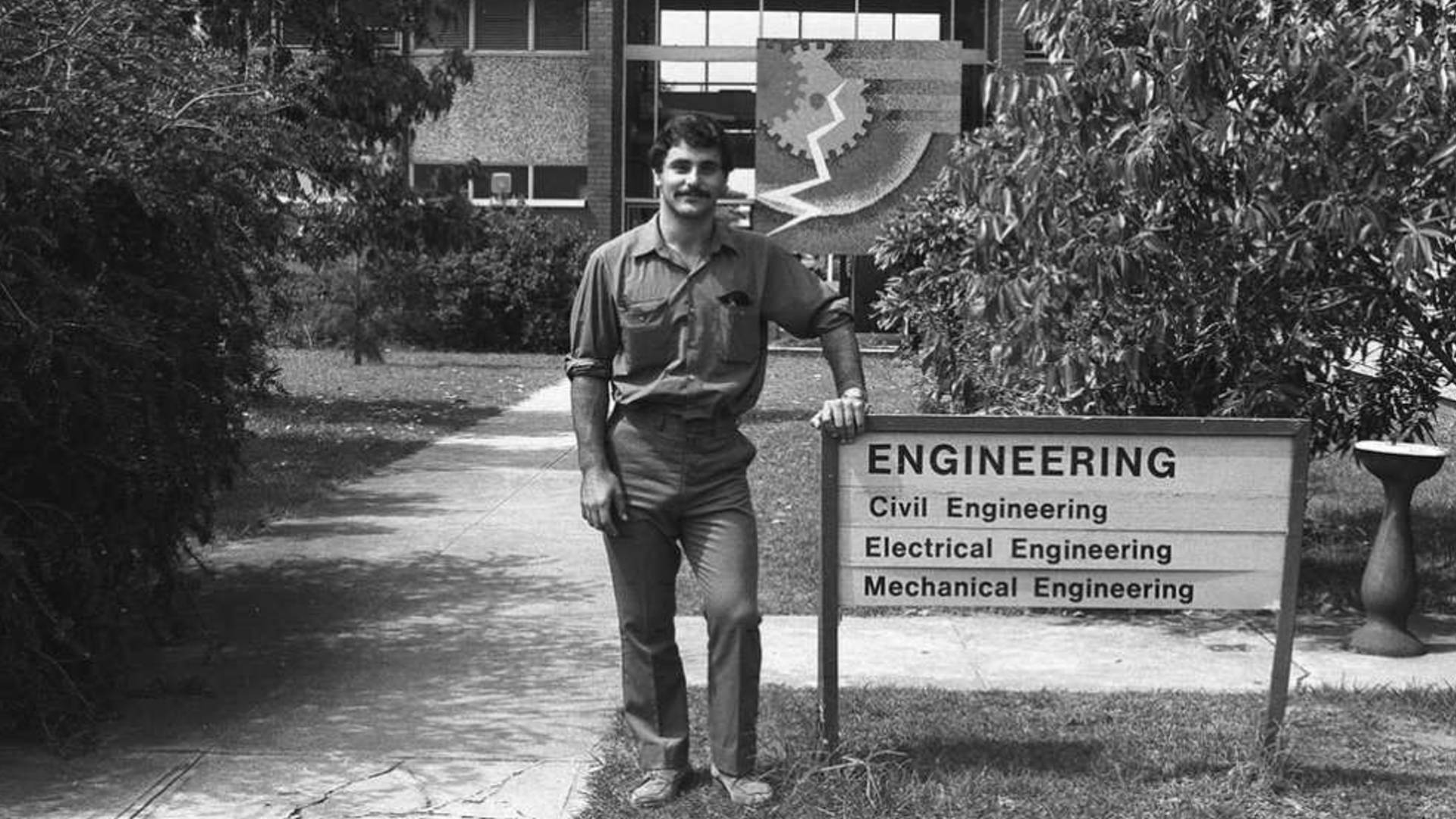June 28, 2021
History of School of Mechanical, Materials, Mechatronic and Biomedical Engineering (MMMB)
Overview
The school takes its name from its disciplines, in the order determined by their year of establishment. Mechanical engineering and biomedical engineering being its first discipline and last discipline, respectively. The school of MMMB was initially formed with its first 3 disciplines in 2003. With the establishment of Biomedical Engineering in 2017, its name was officially changed to School of Mechanical, Materials, Mechatronic and Biomedical Engineering (MMMB) on March 3, 2017. It has been led by the heads of school presented in Table 1. The history of the school is based on the history of its disciplines.
Table 1: Heads of School of MMMB since it's establishment
| Head of School | Duration |
|---|---|
| Professor Kiet Tieu | 2003 – 2008 |
| Professor Paul Cooper | 2008 – 2010 |
| Associate Professor Sharon Nightingale | 2010 – 2011 |
| Professor Gursel Alici | 2011 – Current |
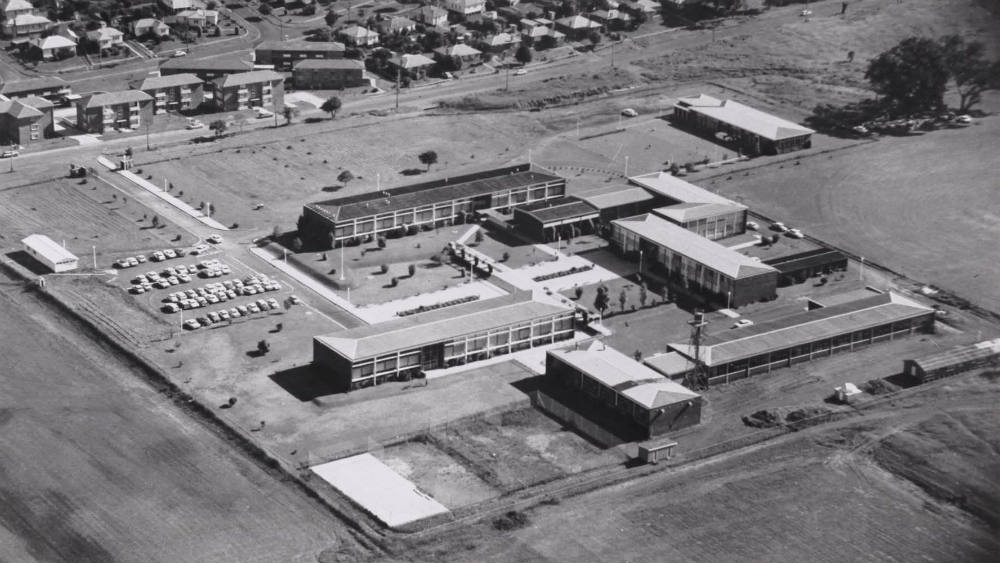
History of Mechanical Engineering
Mechanical Engineering at a professional level has been available to students at Wollongong since 1951 when the New South Wales University of Technology established a Division at Wollongong in 1951. The Division was located at the Wollongong Technical College in Gladstone Avenue. The first fulltime academic staff were appointed in 1955. When the Wollongong University College was established on the present University site in 1962, one of the foundation departments was Mechanical Engineering, which in those days had six full-time academic staff together with the College Warden who was also Professor of Engineering.
The status quo was preserved until 1960 when a Department of Mechanical, Civil and Mining Engineering was established to give recognition to the fact that courses in Civil Engineering and later Mining Engineering had commenced in Wollongong. This combined department was renamed a School in 1973 (with the Department of Systems, Structural and Thermal Engineering). When the decision was taken to grant the University of Wollongong its autonomy and the new academic structure was determined in 1974, the Department of Mechanical Engineering was established with an academic staff of five. It can be seen that during the twelve year period of turmoil from 1962 to 1974 when other branches of engineering were developing at Wollongong, the academic staff concerned with teaching mechanical engineering dropped from over six to five.
The foundation Chair of Mechanical Engineering was established in 1974 and filled by Professor S. A. Marshall in late 1975. Professor Marshall had been a senior lecturer in the Department of Control Engineering at Sheffield University prior to his appointment to Wollongong. After 1975, the Department continued making steady progress as a rigorous contributor to the teaching of traditional mechanical engineering. Table 2 shows the list of HOS from 1975-1999.
Since 1975, the Department has continued to make steady progress until it became part of the School of Mechanical, Materials and Mechatronic Engineering in 2003. Within that School mechanical engineering continues to be an important and contributing component.
| Head of School | Duration |
|---|---|
| Professor Sam Marshall | 1975-1982 |
| Professor Peter Arnold | 1982-1992 |
| Associate Professor John Montagner | 1992-1996 |
| Professor Michael West | 1996-1997 |
| Professor Kiet Tieu | 1997-1999 |
| Leader of Mechanical Engineering Discipline | Duration |
|---|---|
| Professor Kiet Tieu | 2000-2002 |
Although constrained by significant teaching commitments the academic staff strive to maintain an active research program some of which have attracted significant external funding and worldwide recognition. An essential component of research is publication both in peer-reviewed journals and at international conferences. Some areas of research have been undertaken for many years. For example the bulk solids research program came to Wollongong from Kensington in 1958 with Alan Roberts who was studying to performance of grain augers for his PhD. This program has continued and developed ever since.
In some of the research areas staff regard responding to the requests by industry to act as consultants as an important activity. This provides an opportunity to communicate and apply research findings to industry (providing in some instances “full scale laboratory facilities” to further the research), to become aware of current problems which require research and to attract research funds from industry or from funding bodies where industry representatives have a significant influence.
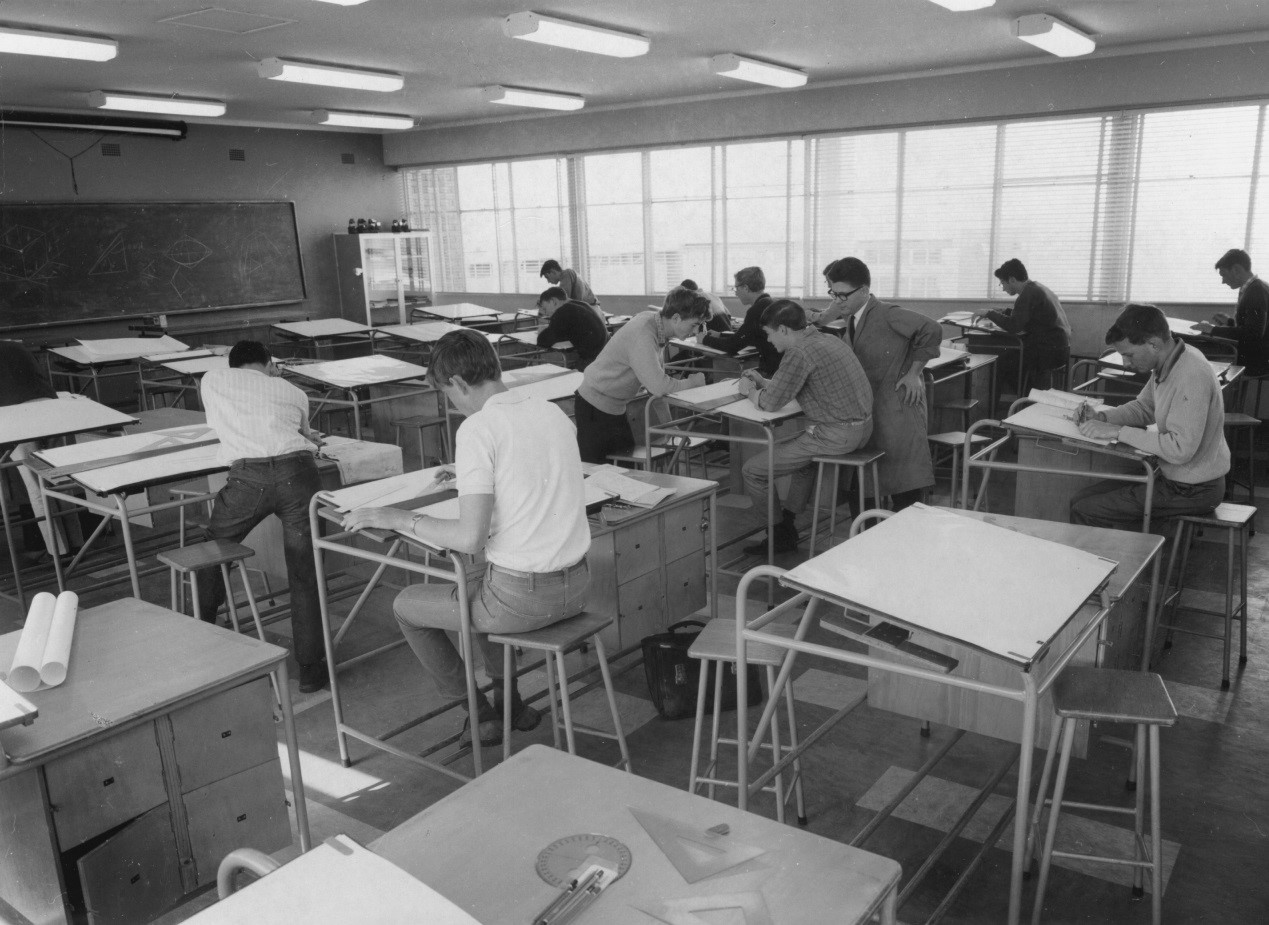
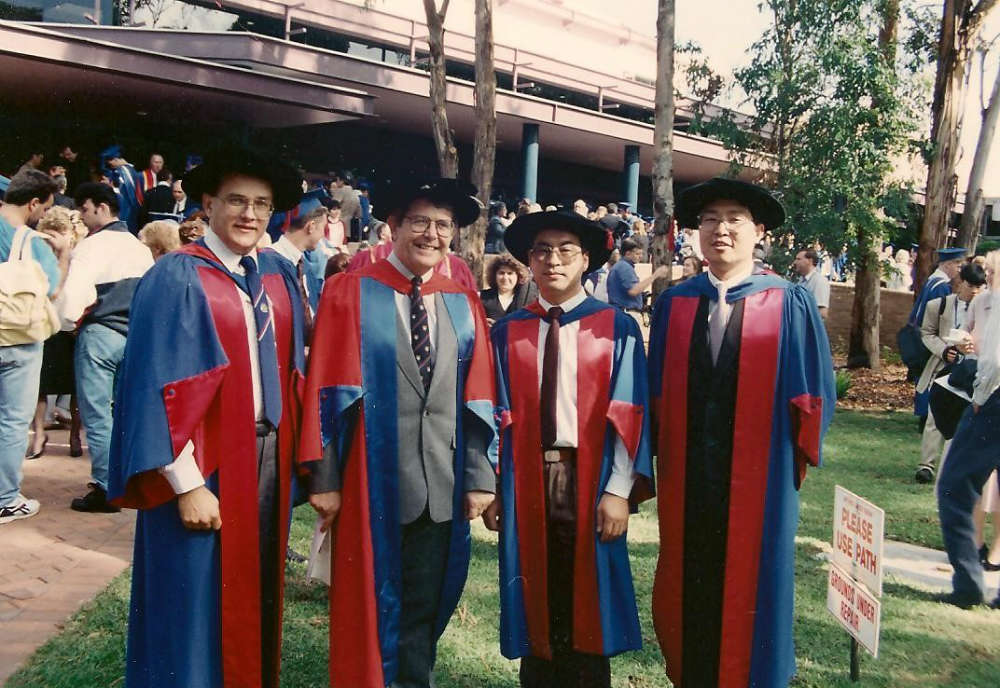
History of Metallurgy and Materials Engineering
Metallurgy was a core Bachelor degree program of the University of Wollongong when it was established as a University College of the University of New South Wales in 1962. The Department of Metallurgy grew in size and stature over the next two decades until, in 1986, when the Department of Metallurgy was re-badged as Metallurgy and Materials Engineering. Although this change was made because of the growing importance of non-metallic materials, metallurgy remained the major core of the undergraduate degree. Four years later, there was another name change to the simpler and more inclusive label, “Materials Engineering”. For forty years, the degree course was the major academic responsibility of the staff of an independent Department (1962-1998) and then, Discipline (1998-2002). However, a restructure of the Faculty occurred early in 2003 in response to low undergraduate enrolments in Engineering, particularly in Materials Engineering, with the creation of the School of Mechanical, Materials and Mechatronic Engineering – a radical change in status that offered new challenges, as well as new opportunities.
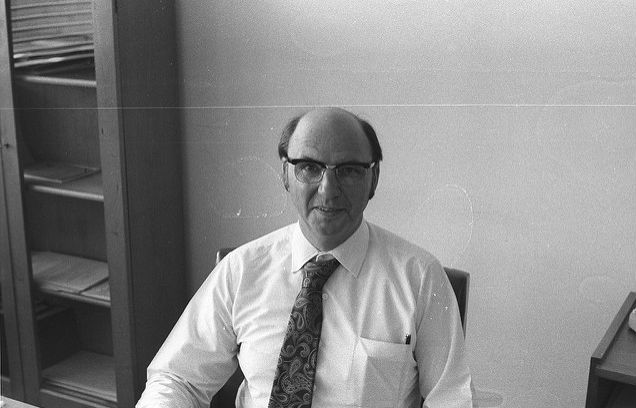
Figure 4-April 1975 - Professor Geoffrey Brinson. Head of the Division of Engineering and Metallurgy
Future decades will see how the fortunes of Materials unfold at the University of Wollongong, but the account given here mainly concerns the history of Materials over the first four decades, a period defined by the existence of the discipline as an autonomous unit within the Faculty of Engineering. Over these forty years, four Professors: Geoffrey Brinson, William Plumbridge, Noel Kennon and Druce Dunne provided the leadership of the Department or Discipline.
The Sixties and Seventies
Geoffrey Brinson was appointed as the Foundation Professor of Metallurgy in 1969 – a position endowed by Australian Iron and Steel Pty Ltd. He joined the Department of Metallurgy at Wollongong towards the end of 1961 after spending four years in the Department of Metallurgy at the University of Sheffield. At this time, the “embryonic University” had been in existence since 1952, offering diploma courses under the auspices of the NSW University of Technology, which subsequently became the University of New South Wales. The resident lecturer of the Department during this period was Tom Barnes.
It was not until 1962 that the institution formally became a College of the University of New South Wales and degree courses were offered. Expansion of the teaching staff numbers became imperative to provide the degree course in Metallurgy and, to this end, Bob Robins was recruited to establish subjects in extractive metallurgy. During 1962 Noel Kennon also joined the Department from the School of Metallurgy at UNSW, adding significant strength in the area of physical metallurgy.
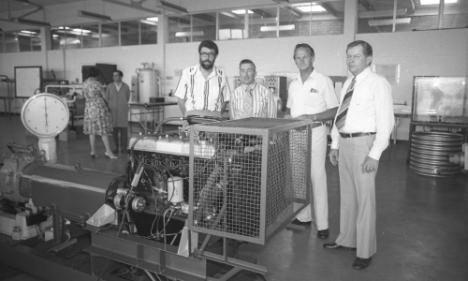
22 November 1978. Donation of 6 cylinder “Land Cruiser” engine to Department of Mechanical Engineering by Thiess Toyota Pty Ltd. Professor S.A. Marshall, Mr R.J. Hancock, Mr. P. Scott, Professor S.E. Bonamy
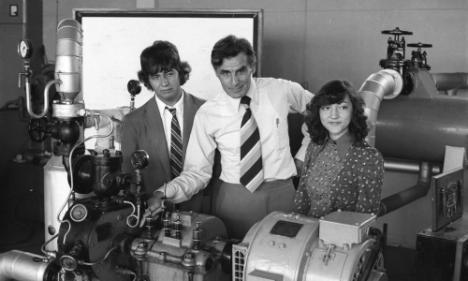
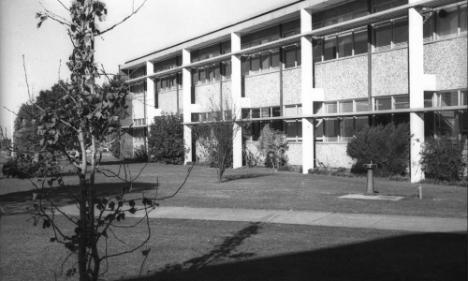
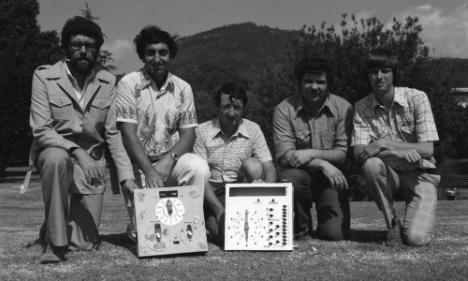
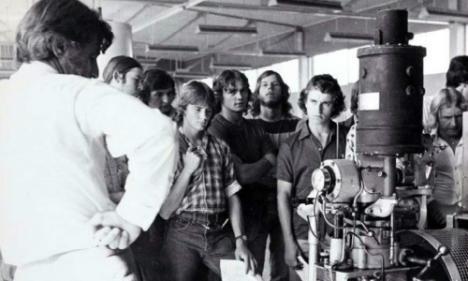
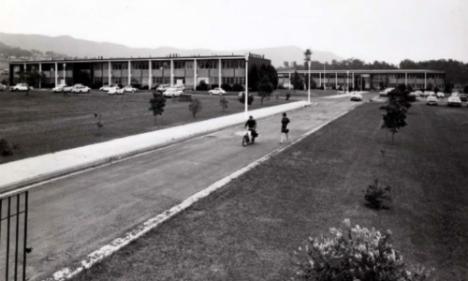
UOW campus 1970s
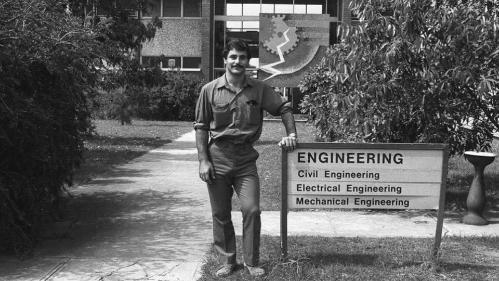
Engineering Student outside the Engineering Building 1980
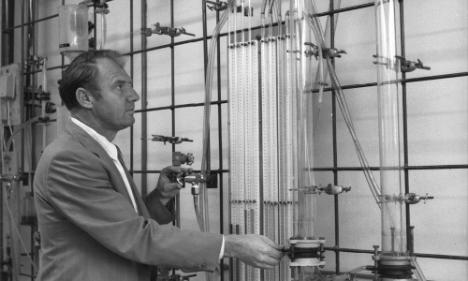
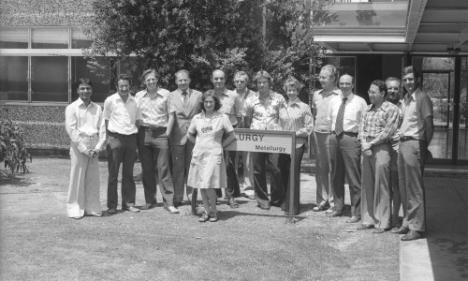
November 1979. Staff of Department of Metallurgy.
In 1964 Bob Robins decided to return to chemical engineering at the UNSW and was replaced by Nick Standish (extractive metallurgy) and Steve Merrick (mineral processing). Steve left after about a year, but Nick stayed on and provided the bulk of the extractive metallurgy coursework over the next 25 years. In the mid ’70s, Nick was assisted for several years by Brian Collins who was appointed as a Tutor in the Department.
During the late ’60s and early ’70s, the academic staff of the Department was further strengthened by Nony Salasoo (thermodynamics and refractories), Malcolm Atkinson (mechanical metallurgy), Druce Dunne (physical metallurgy and microscopy) and Gordon Delamore (solidification). Tom Barnes retired in 1974 and was succeeded by Tara Chandra (hot working and mechanical metallurgy). The increase in academic staff numbers was accompanied by growth in the technical support staff. A highly skilled and resourceful group of people was assembled, greatly assisting the teaching and research programs undertaken by the Department. Technical and laboratory support staff in the first decade of the Department included Roy Barnard, Ken Ireland, Graeme Chegwidden, David Flynn, Bob Goff, Mary Gallagher, John Lewin and Olga Treay. From the mid ’70s new faces started to appear: Fred Groves, Ron Kinnell, Bob de Jong, Darius Krivenek and Graham Hamilton in the mechanical and electrical workshops; and Margaret Standen and Tony Pearce in the metallography, microscopy and other laboratories. John Lewin, the last remaining technical staff member of the ’60s group, resigned in the early ’80s. Two research assistants were appointed at around the end of the ’70s: Lyn Middleton (1978) and Jeune Eshman (1981). Both research staff members contributed many years of valuable service to the Department.
The Eighties
Following the retirement of Geoff Brinson in 1984, the Departmental Review Committee charted a new course from metallurgy to a materials degree program. The Department was re-named Metallurgy and Materials Engineering in 1986 and subsequently became the Department of Materials Engineering (1988). The Chair was offered to Bill Plumbridge, from Bristol University in the UK. On joining the Department in 1987, Bill set about developing a fully integrated materials course. He resigned in 1990 and in the years before and after his term as Head, the Department was capably led by Noel Kennon.
Sharon Nightingale was appointed as a lecturer in ceramics in 1987 and Udo Buecher was recruited as a polymer specialist in 1988. Sharon and Udo came from BHP and although Sharon stayed on, Udo decided to return to BHP and an industrial career after one year in academia. The vacant position was filled by Geoff Spinks in December 1989. The increase in numbers of academic staff was accompanied by a peak in laboratory and workshop personnel and much of the Department’s success over this period flowed from the skill and innovation of the technical staff in designing, building and maintaining research equipment. Vacant professional and technical staff positions were filled by Ross Smith (electron microscopy) 1982-1988, Greg Tillman (metallography) and Nick Mackie (electron microscopy) in 1989; and Andrew Scobie (workshop) in 1992.
The Nineties
Druce Dunne was appointed to the Chair of Materials Engineering in 1992. The period of 1988 to 1998 was marked by especially strong research output, catalysed by peak academic staff numbers, the employment of more than 15 postdoctoral researchers on limited term contracts and up to about 60 research students. Most of the research activity over this period was conducted within the Advanced Materials and Surface Engineering Program (1989-1995) and the Research Centre for Advanced Materials Processing (1995-2003). Both of these research centres were initiated and led by Druce Dunne and they enjoyed substantial success in attracting government and industrial research funding. By the late ’90s, larger research enterprises had evolved from this fertile research background: the CRC for Materials Welding and Joining (led by Professor John Norrish), the Institute for Superconducting and Electronic Materials (ISEM, Professor S.X. Dou), and the BHP Institute for Steel Processing and Products (ISPP, Professor Rian Dippenaar). In addition, Geoff Spinks was contributing significantly to the Faculty of Science’s Intelligent Polymer Research Institute (IPRI). The materials research area was firmly established as a major contributor to the high profile research activity of the University.
The inflow of research funding was used in part to employ Postdoctoral Fellows and many talented researchers typically spent periods of 1 to 5 years in the Department before moving on to other positions. Much of the research success of the Department was due to the substantial contributions of these researchers. One of the longest serving Fellows, David Wexler, holds a continuing appointment and has become a core member of academic staff of the Department. Other contributions to Departmental research or technical support during this period came from Lee Brunckhorst (microscopy, polymer and ceramic materials), Shaun Hamilton (workshop) Steve Blayney (surface engineering laboratory) and Jose Gonzalez (workshop).
From 1992 to 1996 the Department undertook a significant and challenging education and research program with Krakatau Steel in Cilegon, Indonesia. The offshore teaching contract was negotiated by Nick Standish and Noel Kennon and involved delivery of Master of Engineering Practice coursework programs in metallurgy to over 100 engineering staff with no or little formal exposure to materials science and engineering. In addition, 21 ME (Hons) and PhD research projects by materials engineers from Krakatau Steel were successfully completed within this program. The contract was a huge financial and academic success, largely due to the effort and energy of Nick Standish who lived in Indonesia, post-retirement, over the course of the program, skilfully managing and coordinating the program.
A series of retirements, starting with Malcolm Atkinson in 1989 and continuing with Nick Standish (1993), Noel Kennon (1994) and Gordon Delamore (1994), precipitated a series of new academic appointments: Masoud Samandi (1992, surface engineering), Geoff Brooks (1993, extractive metallurgy), Zhixin Chen (1995, electron microscopy), Michael Ferry (1995, physical and mechanical metallurgy) and Andrezj Calka (1996, solidification and powder processing). From 1998 to 2000, Geoff Spinks conducted fulltime research with IPRI and his Departmental duties were taken up by Chris Lukey.
Administrative Assistants certainly played major roles in the smooth conduct of the business of the Department over its four decade lifetime, with notable contributions, in chronological order, from Beatrice Henderson, Mary Faulkner, Felicity Fairlie-Cunninghame, Patricia Batt, Ann Webb, Rhondalee Cambareri and Joy de Mestre. Futhermore, many Honorary staff members made strong contributions to the quality of the teaching and research programs of the Department. Particularly valuable support was contributed by Professor Howard Worner (Illawarra Technology Centre), and Robert Hobbs and Colin Chipperfield of BHP Steel.
The undergraduate curriculum has progressively changed over time to maintain the relevance of the degree program to industrial needs and to conform to restructuring within the Faculty of Engineering. Despite a course focused on the broad sweep of engineering materials, a strong steel metallurgy emphasis has been retained in keeping with the ongoing support of the undergraduate program by BHP. Over the first forty years, about 550 students graduated with Bachelor degrees and about 175 students were awarded ME and PhD research degrees.
The new millennium
Academic staff number peaked at nine in the mid ’90s but they subsequently fell due to the resignations of Ferry (2000), Brooks (2000) and Samandi (2001). The net number of academic staff decreased to seven after the extractive metallurgy position was filled by Brian Monaghan in the second half of 2001. Druce Dunne retired in May 2003, and become an Honorary Professor of the Faculty of Engineering. David Nolan was appointed as a Senior Lecturer in July 2003, maintaining the core of seven staff members, and fortifying the metallurgical expertise available within the Materials Discipline.
Following the retirements of Druce Dunne and Tara Chandra, the termination of Chris Lukey’s contract and the resignation of David Nolan in the mid to late 2000s, several new staff members were recruited to support metallurgical teaching and research: Professor Elena Pereloma, Associate Professor Zaiping Guo, Dr Yue Zhao and Dr Marimthu Muraganant. In 2011 Professor Geoff Spinks was awarded an ARC Professorial position to conduct full-time research on intelligent polymers at the Innovation Campus. His departure led to appointment of two replacement teaching staff: Drs Sandra Cram and Philip Whitten, who contributed to general teaching, but particularly subjects on polymeric materials both in the BE course in Materials Engineering and the BSc course in Nanostructural Materials. Overall, as a result of the strength of Materials in research, the number of academic staff, some with mainly research responsibilities, grew considerably. Including Professors Rian Dippenaar and Hugh Brown, who were originally recruited for the Steel Research Institute, there were, as of September 2011, twelve academic staff members in the Discipline. During this period of rapid restructuring and changes in staffing, firstly Geoff Spinks and then Sharon Nightingale managed the activities of the Discipline of Materials Engineering as it was integrated into the School of Mechanical, Materials and Mechatronic Engineering.
Since its inception the Department (now Discipline) has enjoyed close working partnerships with BHP Steel (now BlueScope Steel), the Wollongong Branch of the Institute of Materials Engineering Australia (IMEA) and the metallurgy and materials undergraduate student society, METSOC. Three of the Departmental Heads (Brinson, Kennon and Dunne) were also Presidents of the Wollongong Branch of the Institute and they, and other academic staff of the Department, contributed strongly to this professional body over many years. These three Heads were also, at different times, Patron of the METSOC.
Appositely, a copper sculpture by a prominent local artist, Gino Sanguinetti, was commissioned by the Wollongong Branch of the Australian Institute of Metals (AIM), for donation to the Department to celebrate the autonomy of the University in 1975. Mr Sanguinetti also created the University Mace used in Graduation Ceremonies. The copper sheet for the Departmental sculpture was donated by Metal Manufactures (MM) Ltd and representatives of BHP Steel, BHP Coated Products, MM and other local industries were members of the AIM Branch Committee, chaired by Malcolm Booth (MM), who developed the idea of this gift to the Department of Metallurgy. This elegant copper sculpture, mounted on a wall in the 2nd floor foyer of Building 1, is an intriguing abstract logo for materials at the University of Wollongong. Although the meaning of the sculpture is highly subjective, there is little doubt that it epitomises the close working partnership between the Department, the Institute and local metallurgical industry. This relationship has flourished, as has the METSOC, despite a sometimes turbulent half-century that has seen the demise of local production of copper, stainless steel and tinplate, and the recent contraction in output of ferritic steels. Despite the inevitability of ups and downs and ongoing changes in the local metallurgical industry, as well as in teaching and research in materials engineering at the University, the longstanding partnerships are expected to continue, and to help maintain Materials as a distinctive discipline within the Faculty of Engineering.
History of Mechatronic Engineering
The discipline of Mechatronic Engineering started its academic life in Autumn 2000.
History of Biomedical Engineering
The discipline of Biomedical Engineering (BMEG) started its academic life in Autumn 2017. The foci of this engineering discipline are medical devices, technologies and systems. These areas of study were selected based on the fact that 55 percent of medical devices companies in Australia are registered in NSW. In addition staff in the school have expertise in medical robotics, assistive and rehabilitation devices, soft robotics, and innovative manufacturing technologies, which have application in medical systems, devices and technologies. This degree is being supported by the existing subjects in the Faculty of Engineering and Information Sciences, Faculty of Science, Medicine, and Health, and a significant number of discipline-specific subjects. The inaugural program director of biomedical engineering is Prof Gursel Alici, who is also the current Head of School.
Contributors
Emeritus Professor Peter Arnold
Emeritus Professor Druce Dunne
Professor Kiet Tieu
Professor Gunter Arndt
Professor Gursel Alici
